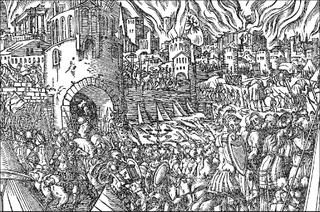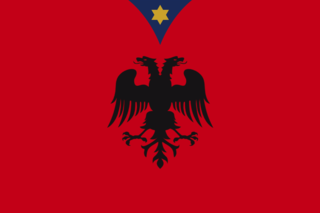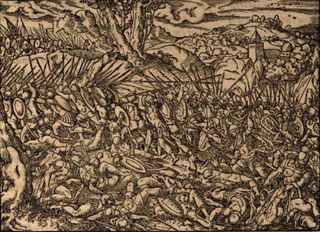
The League of Lezhë was a military and diplomatic alliance of the Albanian aristocracy, created in the city of Lezhë on 2 March 1444. The League of Lezhë is considered the first unified independent Albanian country in the Medieval age, with Skanderbeg as leader of the regional Albanian chieftains and nobles united against the Ottoman Empire. Skanderbeg was proclaimed "Chief of the League of the Albanian People," while Skanderbeg always signed himself as "DominusAlbaniae".

Moisi Golemi, also known as Moisi of Dibra, was an Albanian nobleman and a commander of the League of Lezhë. In 1443–44 he captured all Ottoman holdings in the area of Dibër region. For a brief period in the 1450s he joined the Ottomans, but soon abandoned them and returned to the League. He died in 1464, when he was executed publicly in Constantinople after being captured by the Ottoman army.

The Battle of Albulena, also known as the Battle of Ujëbardha, was fought on 2 September 1457 between Albanian forces led by Skanderbeg and an Ottoman army under Isak bey Evrenoz and Skanderbeg's nephew, Hamza Kastrioti.

Gjergj Arianiti (1383–1462) was an Albanian feudal lord who led several successful campaigns against the Ottoman Empire. He was the father of Donika, Skanderbeg's wife, as well as the grand-uncle of Moisi Arianit Golemi. Gjergj Arianiti was Skanderbeg's ally within League of Lezhë before abandoneding the alliance after the defeat in Berat in 1450. He later returned. Robert Elsie emphasizes that Arianiti was often Skanderbeg's rival. He allied with the Kingdom of Naples in 1446, left his alliance with Skanderbeg by 1449 and allied with Venice in 1456. However his daughter married Skanderbeg and he remained officially part of the League of Lezhe, continuing to fight Ottomans successfully up to his death in 1462.

The first siege of Krujë occurred in 1450 when an Ottoman army led by Sultan Murad II and his crown prince Mehmed II tried to besiege the Albanian town of Krujë. The League of Lezhë, led by Skanderbeg, experienced low morale after losing Svetigrad and Berat between 1448 and 1450. Nevertheless, Skanderbeg's exhortations and the support of the clergy, who claimed to have had visions of angels and victory, motivated the Albanians to defend the capital of the League, Krujë, at all costs. After leaving a protective garrison of 4,000 men under his trusted lieutenant Vrana Konti, Skanderbeg harassed the Ottoman camps around Krujë and attacked the supply caravans of Sultan Murad II's army. By September, the Ottoman camp was in disarray as morale sank and disease ran rampant. The Ottoman army acknowledged that the castle of Krujë would not fall by strength of arms, lifted the siege, and made its way to Edirne. Soon thereafter, in the winter of 1450–51, Murad died in Edirne and was succeeded by his son, Mehmed II.

The second siege of Krujë took place from 1466 to 1467. Sultan Mehmed II of the Ottoman Empire led an army into Albania to defeat Skanderbeg, the leader of the League of Lezhë, which was created in 1444 after he began his war against the Ottomans. During the almost year-long siege, Skanderbeg's main fortress, Krujë, withstood the siege while Skanderbeg roamed Albania to gather forces and facilitate the flight of refugees from the civilian areas that were attacked by the Ottomans. Krujë managed to withstand the siege put on it by Ballaban Badera, sanjakbey of the Sanjak of Ohrid, an Albanian brought up in the Ottoman army through the devşirme. By 23 April 1467, the Ottoman army had been defeated and Skanderbeg entered Krujë.

The Kastrioti were an Albanian noble family, active in the 14th and 15th centuries as the rulers of the Principality of Kastrioti. At the beginning of the 15th century, the family controlled a territory in the Mat and Dibra regions. The most notable member was Gjergj Kastrioti, better known as Skanderbeg, regarded today as an Albanian hero for leading the resistance against Mehmed the Conqueror's efforts to expand the Ottoman Empire into Albania. After Skanderbeg's death and the fall of the Principality in 1468, the Kastrioti family gave their allegiance to the Kingdom of Naples and were given control over the Duchy of San Pietro in Galatina and the County of Soleto, now in the Province of Lecce, Italy. Ferrante, son of Gjon Kastrioti II, Duke of Galatina and Count of Soleto, is the direct ancestor of all male members of the Kastrioti family today. Today, the family consists of two Italian branches, one in Lecce and the other in Naples. The descendants of the House of Kastrioti in Italy use the family name "Castriota Scanderbeg".

Gjergj Kastrioti, commonly known as Skanderbeg, was an Albanian feudal lord and military commander who led a rebellion against the Ottoman Empire in what is today Albania, North Macedonia, Greece, Kosovo, Montenegro, and Serbia.
The Battle of Torvioll, also known as the Battle of Lower Dibra, was fought on 29 June 1444 on the Plain of Torvioll, in what is modern-day Albania. Gjergj Kastrioti Skanderbeg was an Ottoman Albanian general who decided to go back to his native land and take the reins of a new Albanian League against the Ottoman Empire. He, along with 300 other Albanians fighting at the Battle of Niš, deserted the Ottoman army to head towards Krujë, which fell quickly through a subversion. He then formed the League of Lezhë, a confederation of Albanian princes united in war against the Ottoman Empire. Murad II, realizing the threat, sent one of his most experienced captains, Ali Pasha, to crush the new state with a force of 25,000-40,000 men.

The Principality of Kastrioti was one of the Albanian principalities during the Late Middle Ages. It was formed by Pal Kastrioti who ruled it until 1407, after which his son, Gjon Kastrioti ruled until his death in 1437 and then ruled by the national hero of Albania, Skanderbeg.

The Second Battle of Oranik took place during the spring of 1456 in the plains of Oranik. Moisi Arianit Golemi, lord of Debar, and one of Skanderbeg's officers, deserted to the Ottomans following the defeat at Berat in 1455. Golemi set off from Adrianople with an army to capture Albania but was swiftly defeated by Skanderbeg's smaller forces.

The Albanian–Venetian War of 1447–48 was waged between Venetian and Ottoman forces against the Albanians under George Kastrioti Skanderbeg. The war was the result of a dispute between the Republic and the Dukagjini family over the possession of the Dagnum fortress. Skanderbeg, then ally of the Dukagjini family, moved against several Venetian held towns along the Albanian coastline, in order to pressure the Venetians into restoring Dagnum. In response, the Republic sent a local force to relieve the besieged fortress of Dagnum, and urged the Ottoman Empire to send an expeditionary force into Albania. At that time the Ottomans were already besieging the fortress of Svetigrad, stretching Skanderbeg's efforts thin.

The siege of Svetigrad or Sfetigrad began on 14 May 1448 when an Ottoman army, led by Sultan Murad II, besieged the fortress of Svetigrad. After the many failed Ottoman expeditions into Albania against the League of Lezhë, a confederation of Albanian Principalities created in 1444 and headed by Skanderbeg, Murad II decided to march an army into Skanderbeg's dominions in order to capture the key Albanian fortress of Svetigrad. The fortress lay on an important route between present-day North Macedonia and Albania, and thus its occupation would give the Ottomans easy access into Albania.

Vrana, historically known as Vrana Konti was an Albanian military leader who was distinguished in the Albanian-Turkish Wars as one of the commanders of Gjergj Kastrioti Skanderbeg, of whom he was one of the closest councillors. He probably belonged to the class of small lords who were tied to the Kastrioti family and possibly belonged to a common lineage (fis) with them. In his youth, he fought as a mercenary in the armies of Alfonso the Magnanimous. The term conte ("count") with which he became known in historical accounts didn't refer to an actual title he held, but to his status as a figure of importance.
Ajdin Muzaka was the brother in law of George Kastrioti Skanderbeg and one of his commanders. He was converted to Islam and served in Ottoman army before joining Skanderbeg in 1443. He was the commander of the central group in the Battle of Torvioll and he played a crucial role in the Albanian victory. He was wounded in that battle and died soon afterwards. He was known for his extreme courage and was the first high-rank Albanian commander who died in Skanderbeg's battles against Ottoman forces.
The Ottoman invasion of Albania in 1452 was a campaign by the newly acceded Ottoman sultan Mehmed II against Skanderbeg, the chief of the League of Lezhë. Shortly after the first siege of Krujë, Murad II died in Edirne, and was succeeded by his son Mehmed II. Mehmed ordered nearly annual invasions of Albania which often resulted in multiple battles in one year. The first of these expeditions was sent in 1452 under the dual command of Hamza Pasha and Tahip Pasha, with an army of approximately 25,000 men.

The Battle of Ohrid took place on 14 or 15 September 1464 between Albanian ruler Skanderbeg's forces and Ottoman forces. A crusade against Sultan Mehmed II had been planned by Pope Pius II with Skanderbeg as one of its main leaders. The battle near Ohrid occurred as a result of an Albanian incursion into Ottoman territory. The Ottomans stationed in the area were assaulted by Skanderbeg's men and 1,000 Venetian soldiers under Cimarosto. The Ottomans were lured out of their protections in Ohrid and ambushed by the Albanian cavalry. Skanderbeg won the resulting battle and his men earned 40,000 ducats after captured Ottoman officers were ransomed. Pius II died before the planned crusade began, however, forcing Skanderbeg to fight his battles virtually alone.
Pal or Gjergj Kastrioti was an Albanian medieval ruler in the latter part of the 14th century in northern Albania. Not much is known about his life. He is mentioned in only two historical sources which describe his rule as extending in a region between Mat and Dibër. His son was Gjon Kastrioti and his grandson Skanderbeg, the Albanian national hero.

Skanderbeg's rebellion was an almost 25-year long anti-Ottoman rebellion led by the Albanian military commander Skanderbeg in what is today Albania and its neighboring countries. It was a rare successful instance of resistance by Christians during the 15th century and through his leadership led Albanians in guerrilla warfare against the Ottomans.

The Albanian-Ottoman Wars (1432–1479) were a series of wars and revolts against the rising Ottoman Empire by Albanian feudal lords. The wars and revolts took place in present-day Albania, Montenegro, Kosovo, North Macedonia and South Serbia. In this period, Albanians under the leadership of Gjergj Arianiti and especially later under Skanderbeg resisted the Ottomans under two Sultans in over 30 battles. Skanderbeg continued this resistance until his death in 1468, and the Albanians persevered for another 11 years before being defeated.
















